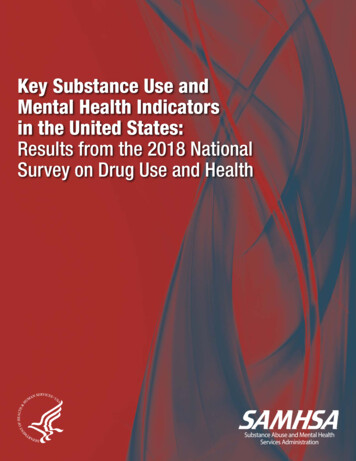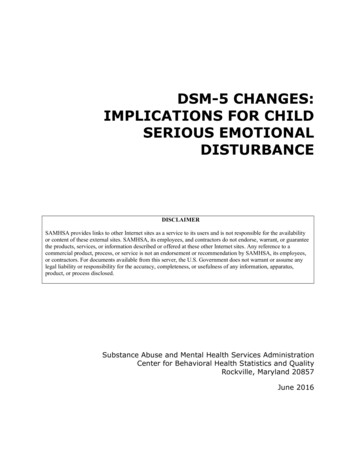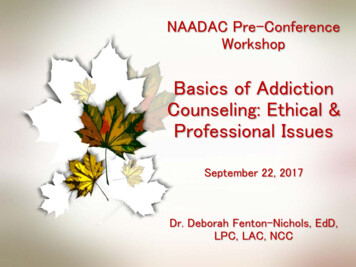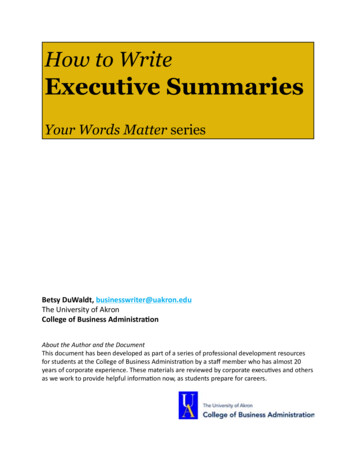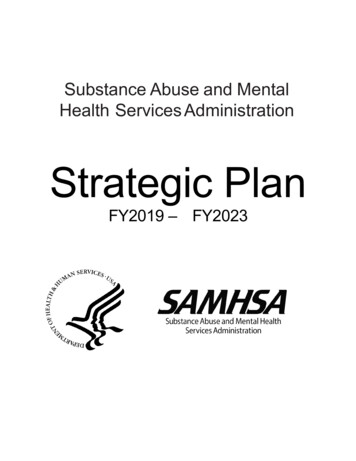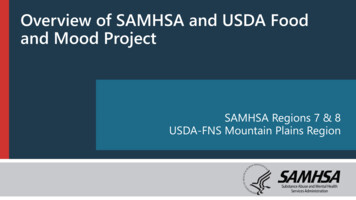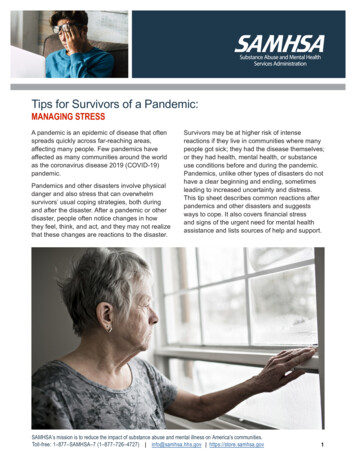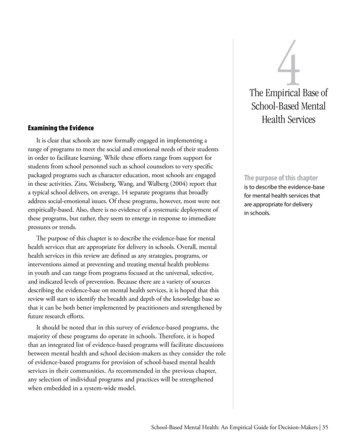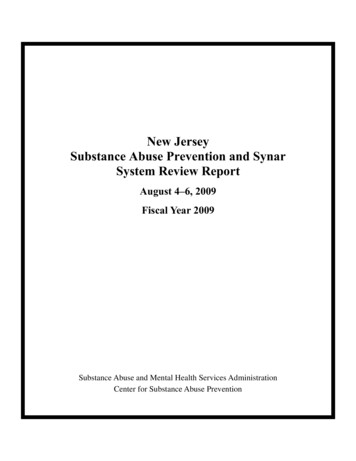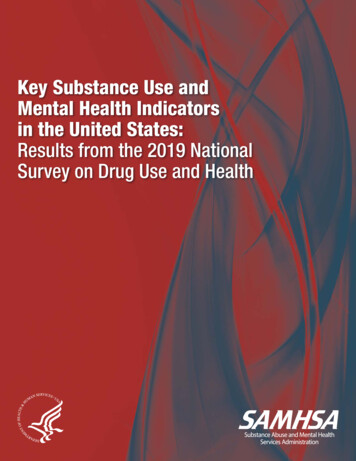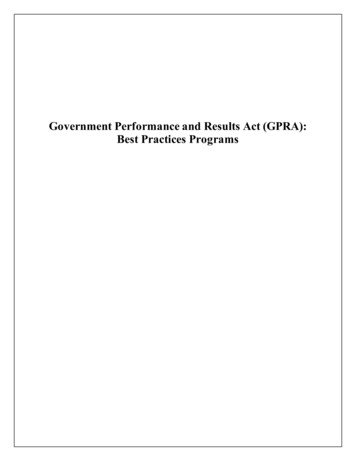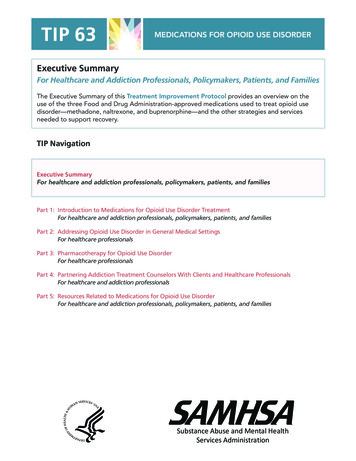
Transcription
TIP 63MEDICATIONS FOR OPIOID USE DISORDERExecutive SummaryFor Healthcare and Addiction Professionals, Policymakers, Patients, and FamiliesThe Executive Summary of this Treatment Improvement Protocol provides an overview on theuse of the three Food and Drug Administration-approved medications used to treat opioid usedisorder—methadone, naltrexone, and buprenorphine—and the other strategies and servicesneeded to support recovery.TIP NavigationExecutive SummaryFor healthcare and addiction professionals, policymakers, patients, and familiesPart 1: Introduction to Medications for Opioid Use Disorder TreatmentFor healthcare and addiction professionals, policymakers, patients, and familiesPart 2: Addressing Opioid Use Disorder in General Medical SettingsFor healthcare professionalsPart 3: Pharmacotherapy for Opioid Use DisorderFor healthcare professionalsPart 4: Partnering Addiction Treatment Counselors With Clients and Healthcare ProfessionalsFor healthcare and addiction professionalsPart 5: Resources Related to Medications for Opioid Use DisorderFor healthcare and addiction professionals, policymakers, patients, and familiesSubstance Abuse and Mental HealthServices Administration
MEDICATIONS FOR OPIOID USE DISORDER—Executive SummaryTIP 63ContentsForeword . . . . . . . . . . . . . . . . . . . . . . . . . . . . . . . . . . . . . . . . . . . . . . . . . . . . . . . . . . . . . . ES-ivTIP 63 Update. . . . . . . . . . . . . . . . . . . . . . . . . . . . . . . . . . . . . . . . . . . . . . . . . . . . . . . . . . ES-ivIntroduction . . . . . . . . . . . . . . . . . . . . . . . . . . . . . . . . . . . . . . . . . . . . . . . . . . . . . . . . . . . . ES-1Overall Key Messages. . . . . . . . . . . . . . . . . . . . . . . . . . . . . . . . . . . . . . . . . . . . . . . . . . . ES-1Content Overview . . . . . . . . . . . . . . . . . . . . . . . . . . . . . . . . . . . . . . . . . . . . . . . . . . . . . . ES-3Part 1: Introduction to Medications for Opioid Use Disorder Treatment . . . . . . . . . . . . . .Part 2: Addressing Opioid Use Disorder in General Medical Settings . . . . . . . . . . . . . . . . .Part 3: Pharmacotherapy for Opioid Use Disorder . . . . . . . . . . . . . . . . . . . . . . . . . . . . . . . .Part 4: Partnering Addiction Treatment Counselors With Clients andHealthcare Professionals . . . . . . . . . . . . . . . . . . . . . . . . . . . . . . . . . . . . . . . . . . . . . . . . . . . .Part 5: Resources Related to Medications for Opioid Use Disorder. . . . . . . . . . . . . . . . . . .ES-3ES-4ES-4ES-5ES-5Notes . . . . . . . . . . . . . . . . . . . . . . . . . . . . . . . . . . . . . . . . . . . . . . . . . . . . . . . . . . . . . . . . . . . ES-7TIP Development Participants. . . . . . . . . . . . . . . . . . . . . . . . . . . . . . . . . . . . . . . . . . . ES-9Expert Panelists . . . . . . . . . . . . . . . . . . . . . . . . . . . . . . . . . . . . . . . . . . . . . . . . . . . . . . . . . . . . ES-9Scientific Reviewers . . . . . . . . . . . . . . . . . . . . . . . . . . . . . . . . . . . . . . . . . . . . . . . . . . . . . . . . ES-10Field Reviewers. . . . . . . . . . . . . . . . . . . . . . . . . . . . . . . . . . . . . . . . . . . . . . . . . . . . . . . . . . . . ES-10Publication Information. . . . . . . . . . . . . . . . . . . . . . . . . . . . . . . . . . . . . . . . . . . . . . . . ES-12ES-iii
TIP 63MEDICATIONS FOR OPIOID USE DISORDER—Executive SummaryForewordThe Substance Abuse and Mental Health Services Administration (SAMHSA) is the U.S. Department ofHealth and Human Services agency that leads public health efforts to reduce the impact of substanceabuse and mental illness on America’s communities. An important component of SAMHSA’s work isfocused on dissemination of evidence-based practices and providing training and technical assistanceto healthcare practitioners on implementation of these best practices.The Treatment Improvement Protocol (TIP) series contributes to SAMHSA’s mission by providingscience-based, best-practice guidance to the behavioral health field. TIPs reflect careful considerationof all relevant clinical and health services research, demonstrated experience, and implementationrequirements. Select nonfederal clinical researchers, service providers, program administrators, andpatient advocates comprising each TIP’s consensus panel discuss these factors, offering input on theTIP’s specific topics in their areas of expertise to reach consensus on best practices. Field reviewers thenassess draft content and the TIP is finalized.The talent, dedication, and hard work that TIP panelists and reviewers bring to this highly participatoryprocess have helped bridge the gap between the promise of research and the needs of practicingclinicians and administrators to serve, in the most scientifically sound and effective ways, people inneed of care and treatment of mental and substance use disorders. My sincere thanks to all who havecontributed their time and expertise to the development of this TIP. It is my hope that clinicians will findit useful and informative to their work.Elinore F. McCance-Katz, M.D., Ph.D.Assistant Secretary for Mental Health and Substance UseU.S. Department of Health and Human ServicesSubstance Abuse and Mental Health Services AdministrationTIP 63 UpdateTo ensure that the content of this TIP is as up to date and as useful to readers as possible, SAMHSA,in January 2020, revised certain areas of all five parts. These changes will help provide readers withthe latest information needed to understand medications for opioid use disorder. These changesincluded the following: Updating statistics from SAMHSA, the Centers for Disease Control and Prevention, and otherhealth authorities on opioid-related deaths, overdoses, accidents, and hospitalizations.Updating the expanded list of other qualifying practitioners who are eligible to apply for a waiverto prescribe buprenorphine (i.e., clinical nurse specialists, certified registered nurse anesthetists,and certified nurse midwives).Clarifying that buprenorphine is available in an extended-release injection formulation.Adding information about the use of subdermal formulations of buprenorphine (i.e., Probuphineand Sublocade).Adding information about possible clinical interactions between formulations of buprenorphineand naltrexone with various other medications and products.Improving the language to make clear the importance of testing for HIV and hepatitis C.Updating recommendations from the U.S. Preventive Services Task Force on performing drugscreening for adults in primary care settings.Removing or replacing broken hyperlinks to online resources.ES-iv
TIP 63MEDICATIONS FOR OPIOID USE DISORDERExecutive SummaryThe goal of treatment for opioid addiction or opioid use disorder (OUD) is remission of thedisorder leading to lasting recovery. Recovery is a process of change through which individuals improve their health and wellness, live self-directed lives, and strive to reach their fullpotential.1 This Treatment Improvement Protocol (TIP) reviews the use of the three Foodand Drug Administration (FDA)-approved medications used to treat OUD—methadone,naltrexone, and buprenorphine—and the other strategies and services needed to supportrecovery for people with OUD.IntroductionOur nation faces a crisis of overdose deaths fromopioids, including heroin, illicit fentanyl, andprescription opioids. These deaths represent amere fraction of the total number of Americansharmed by opioid misuse and addiction. ManyAmericans now suffer daily from a chronicmedical illness called “opioid addiction” orOUD (see the Glossary in Part 5 of this TIP fordefinitions). Healthcare professionals, treatmentproviders, and policymakers have a responsibilityto expand access to evidence-based, effectivecare for people with OUD.Estimated costof the OPIOIDEPIDEMIC was 504BILLIONin 2015.2An expert panel developed the TIP’s contentbased on a review of the literature and on theirextensive experience in the field of addictiontreatment. Other professionals also generouslycontributed their time and commitment to thisproject.An estimated 1.7MAMERICANShave OUD related toopioid painkillers;526K have heroinrelated OUD.3The TIP is divided into parts so that readers caneasily find the material they need. Part 1 is ageneral introduction to providing medicationsfor OUD and issues related to providing thattreatment. Some readers may prefer to go directlyto those parts most relevant to their areas ofinterest, but everyone is encouraged to readPart 1 to establish a shared understanding ofkey facts and issues covered in detail in this TIP.Following is a summary of the TIP’s overall mainpoints and brief summaries of each of the fiveTIP parts.Overall Key MessagesAddiction is a chronic, treatable illness.Opioid addiction, which generally correspondswith moderate to severe forms of OUD, oftenrequires continuing care for effective treatmentrather than an episodic, acute-care treatmentapproach.ES-1
TIP 63Medications for Opioid Use DisorderOpioid overdose caused46,800 DEATHSnationwide in 2018—this exceeded the #caused by motor vehiclecrashes.4,5General principles of good care for chronicdiseases can guide OUD treatment.Approaching OUD as a chronic illness canhelp providers deliver care that helps patientsstabilize, achieve remission of symptoms, andestablish and maintain recovery.Patient-centered care empowers patientswith information that helps them make bettertreatment decisions with the healthcareprofessionals involved in their care. Patientsshould receive information from their healthcareteam that will help them understand OUD andthe options for treating it, including treatmentwith FDA-approved medication.Patients with OUD should have access tomental health services as needed, medicalcare, and addiction counseling, as well asrecovery support services, to supplementtreatment with medication.The words you use to describe OUD andan individual with OUD are powerful. ThisTIP defines, uses, and encourages providersto adopt terminology that will not reinforceprejudice, negative attitudes, or discrimination.There is no “one size fits all” approach toOUD treatment. Many people with OUD benefitfrom treatment with medication for varyinglengths of time, including lifelong treatment.Ongoing outpatient medication treatment forOUD is linked to better retention and outcomesES-2than treatment without medication. Even so,some people stop using opioids on their own;others recover through support groups orspecialty treatment with or without medication.The science demonstrating the effectivenessof medication for OUD is strong. For example,methadone, extended-release injectable naltrexone (XR-NTX), and buprenorphine were eachfound to be more effective in reducing illicitopioid use than no medication in randomizedclinical trials, which are the gold standard fordemonstrating efficacy in clinical medicine.6,7,8,9,10Methadone and buprenorphine treatmenthave also been associated with reduced risk ofoverdose death.11,12,13,14,15This doesn’t mean that remission and recoveryoccur only through medication. Some peopleachieve remission without OUD medication, justas some people can manage type 2 diabeteswith exercise and diet alone. But just as it isinadvisable to deny people with diabetes themedication they need to help manage theirillness, it is also not sound medical practice todeny people with OUD access to FDA-approvedmedications for their illness.Medication for OUD should be successfullyintegrated with outpatient and residentialtreatment. Some patients may benefit fromdifferent levels of care at different points in theirlives, such as outpatient counseling, intensiveoutpatient treatment, inpatient treatment, orlong-term therapeutic communities. Patientstreated in these settings should have access toOUD medications.2 MILLIONpeople in the U.S.,ages 12 and older,had OUD involvingPRESCRIPTIONOPIOIDS, HEROIN,or both in 2018.16
TIP 63Executive SummaryPatients treated with medications for OUDcan benefit from individualized psychosocialsupports. These can be offered by patients’healthcare providers in the form of medicationmanagement and supportive counseling and/orby other providers offering adjunctive addictioncounseling, recovery coaching, mental healthservices, and other services that may be neededby particular patients.Expanding access to OUD medications isan important public health strategy. 17 Thegap between the number of people needingopioid addiction treatment and the capacity totreat them with OUD medication is substantial.In 2012, the gap was estimated at nearly 1million people, with about 80 percent of opioidtreatment programs (OTPs) nationally operatingat 80 percent capacity or greater.18O P I O I D - R E L AT E DEMERGENCYDEPARTMENTvisits more than doubledfrom 2005 to 2016.22,23 In Part 1, readers will learn that: Improving access to treatment with OUDmedications is crucial to closing the widegap between treatment need and treatmentavailability, given the strong evidence ofeffectiveness for such treatments.19 Data indicate that medications for OUD arecost effective and cost beneficial.20,21 Content OverviewThe TIP is divided into parts to make the materialmore accessible according to the reader’s interests.Part 1: Introduction to Medications forOpioid Use Disorder TreatmentThis part lays the groundwork for understandingtreatment concepts discussed later in this TIP.The intended audience includes: Healthcare professionals (physicians, nursepractitioners, physician assistants, and, untilOctober 1, 2023, clinical nurse specialists,certified registered nurse anesthetists, andcertified nurse midwives).Professionals who offer addiction counselingor mental health services.Peer support specialists.People needing treatment and their families.People in remission or recovery and theirfamilies.Hospital administrators.Policymakers. Increasing opioid overdose deaths, illicitopioid use, and prescription opioid misuseconstitute a public health crisis.OUD medications reduce illicit opioid use,retain people in treatment, and reduce risk ofopioid overdose death better than treatmentwith placebo or no medication.Only physicians; nurse practitioners; physicianassistants; and, until October 1, 2023, clinicalnurse specialists, certified registered nurseanesthetists, and certified nurse midwives canprescribe buprenorphine for OUD. They mustget a federal waiver to do so.Only federally certified, accredited OTPs candispense methadone to treat OUD. OTPscan administer and dispense buprenorphinewithout a federal waiver.Any prescriber can offer naltrexone.OUD medication can be taken on a short- orlong-term basis, including as part of medicallysupervised withdrawal and as maintenancetreatment.Patients taking medication for OUD areconsidered to be in recovery.Several barriers contribute to the underuse ofmedication for OUD.ES-3
TIP 63Medications for Opioid Use DisorderEVERYONE AGES15 TO 65 should betested at least ONCEfor HIV. Persons atHIGHER RISK, such aspeople who use DRUGSby injection, should betested ANNUALLY. HIVHep CAnyone who is injectingor has ever INJECTEDDRUGS, even ONCE,no matter how longago, should be TESTEDfor HEPATITIS C,regardless of theirintention to seekTREATMENTforSUD.24,25When patients screen positive for risk of harmfrom substance use, practitioners shouldassess them using tools that determinewhether substance use meets diagnosticcriteria for a substance use disorder (SUD).Thorough assessment should addresspatients’ medical, social, SUD, and familyhistories.Laboratory tests can inform treatmentplanning.Practitioners should develop treatment plansor referral strategies (if onsite SUD treatmentis unavailable) for patients who need SUDtreatment.Part 3: Pharmacotherapy for Opioid UseDisorderThis part offers information and tools for healthcare professionals who prescribe, administer,or dispense OUD medications or treat otherillnesses in patients who take these medications.It provides guidance on the use of buprenorphine,methadone, and naltrexone by healthcareprofessionals in: General medical settings, including hospitals.Office-based opioid treatment settings.Specialty addiction treatment programs,including OTPs.In Part 3, readers will learn that:Part 2: Addressing Opioid Use Disorder inGeneral Medical SettingsThis part offers guidance on OUD screening,assessment, treatment, and referral. Part 2 isfor healthcare professionals working in generalmedical settings with patients who have or areat risk for OUD.In Part 2, readers will learn that: All healthcare practices should screen foralcohol, tobacco, and other substance misuse(including opioid misuse).Validated screening tools, symptom surveys,and other resources are readily available; thispart lists many of them.ES-4 OUD medications are safe and effective whenused appropriately.OPIOID-RELATEDinpatient hospital staysINCREASED 117%nationally from 2005 to 2016.26,27
TIP 63Executive Summary OUD medications can help patients reduce orstop illicit opioid use and improve their healthand functioning.Pharmacotherapy should be considered for allpatients with OUD. Opioid pharmacotherapies should be reserved for those with moderate-to-severe OUD with physical dependence.Patients with OUD should be informed ofthe risks and benefits of pharmacotherapy,treatment without medication, and notreatment.Patients should be advised on where and howto get treatment with OUD medication.Doses and schedules of pharmacotherapymust be individualized.Part 4: Partnering Addiction TreatmentCounselors With Clients and HealthcareProfessionalsThis part recommends ways that addictiontreatment counselors can collaborate withhealthcare professionals to support clientcentered, trauma-informed OUD treatmentand recovery. It also serves as a quick guide tomedications that can treat OUD and presentsstrategies for clear communication with prescribers, creation of supportive environmentsfor clients who take OUD medication, and waysto address other common counseling concernswhen working with this population.In Part 4, readers will learn that: Many patients taking OUD medication benefitfrom counseling as part of treatment.Counselors play the same role for clients withOUD who take medication as for clients withany other SUD.Counselors help clients recover by addressingthe challenges and consequences of addiction.OUD is often a chronic illness requiringongoing communication among patients andproviders to ensure that patients fully benefitfrom both pharmacotherapy and psychosocialtreatment and support.OPIOID ADDICTIONis linked with high rates ofILLEGAL ACTIVITY andINCARCERATION.28,29 OUD medications are safe and effective whenprescribed and taken appropriately.Medication is integral to recovery for manypeople with OUD. Medication usuallyproduces better treatment outcomes thanoutpatient treatment without medication.Supportive counseling environments forclients who take OUD medication canpromote treatment and help build recoverycapital.Part 5: Resources Related to Medicationsfor Opioid Use DisorderThis part has a glossary and audience-segmentedresource lists to help medical and behavioralhealth service providers better understand howto use OUD medications with their patients andto help patients better understand how OUDmedications work. It is for all interested readers.In Part 5, readers will learn that: Practice guidelines and decision-making toolscan help healthcare professionals with OUDscreening, assessment, diagnosis, treatmentplanning, and referral.Patient- and family-oriented resources provideinformation about opioid addiction in general;the role of medication, behavioral and supportive services, and mutual-help groups inthe treatment of OUD; how-tos for identifyingrecovery support services; and how-tos forlocating medical and behavioral health serviceproviders who specialize in treating OUD orother SUDs.ES-5
TIP 63Medications for Opioid Use DisorderEXHIBIT 1.2. Comparison of Medications for RENORPHINEMechanism ofAction at muOpioid ReceptorAgonistAntagonistPartial agonistPhase cePrevention of relapse toopioid misuse, followingmedically supervisedwithdrawalMedically supervised withdrawal,maintenanceRoute ofAdministrationOralOral, intramuscularextended-releaseSublingual, buccal, subdermalimplant, subcutaneous extendedrelease injectionPossible rydepression,sedation, QTprolongation,sexual dysfunction,severe hypotensionincludingorthostatichypotension andsyncope, misusepotential, neonatalabstinencesyndromeNausea, anxiety,insomnia, precipitatedopioid withdrawal,hepatotoxicity,vulnerability to opioidoverdose, depression,suicidality, musclecramps, dizziness orsyncope, somnolenceor sedation, anorexia,decreased appetite orother appetite disordersConstipation, nausea,precipitated opioid withdrawal,excessive sweating, insomnia,pain, peripheral edema,respiratory depression(particularly combined withbenzodiazepines or other CNSdepressants), misuse potential,neonatal abstinence syndromeSchedule II; onlyavailable at federallycertified OTPs andthe acute inpatienthospital setting forOUD treatmentNot a scheduledmedication; not includedin OTP regulations;requires prescription;office-based treatmentor specialty substanceuse treatment programs,including OTPsRegulations andAvailabilityIntramuscular: Pain,swelling, induration(including some casesrequiring surgicalintervention)Implant: Nerve damage duringinsertion/removal, accidentaloverdose or misuse if extruded,local migration or protrusionSubcutaneous Injection:Injection site itching or pain,death from intravenous injectionSchedule III; requires waiver toprescribe outside OTPsImplant: Prescribers must becertified in the ProbuphineRisk Evaluation and MitigationStrategy (REMS) Program.Providers who wish to insert/remove implants are requiredto obtain special trainingand certification in the REMSProgramSubcutaneous Injection:Healthcare settings andpharmacies must be certifiedin the Sublocade REMSProgram and only dispense themedication directly to a providerfor administrationAdapted with permission.30 Copyrighted 2017. UBM Medica. 131265:0917SHES-6
Executive SummaryNotes1Substance Abuse and Mental Health ServicesAdministration. (2017). Recovery and recovery support[Webpage]. Retrieved November 17, 2017, fromwww.samhsa.gov/recovery2Council of Economic Advisers. (2017, November). Theunderestimated cost of the opioid crisis. Washington,DC: Executive Office of the President of the UnitedStates.3Substance Abuse and Mental Health ServicesAdministration. (2019). Results from the 2018 NationalSurvey on Drug Use and Health: Detailed tables.Rockville, MD: Center for Behavioral Health Statisticsand Quality, Substance Abuse and Mental HealthServices Administration. Retrieved January 11, 2020,from https://www.samhsa.gov/data/4Centers for Disease Control and Prevention, NationalCenter for Health Statistics. (2020). Multiple Cause ofDeath 1999-2018 on CDC WONDER Online Database,released in 2020. Retrieved March 12, 2020, fromhttp://wonder.cdc.gov/mcd-icd10.html5National Highway Traffic Safety Administration.(2020). Fatal Motor Vehicle Crashes. Years: 2018.Retrieved March 12, 2020, from nson, R. E., Chutuape, M. A., Strain, E. C.,Walsh, S. L., Stitzer, M. L., & Bigelow, G. E. (2000). Acomparison of levomethadyl acetate, buprenorphine,and methadone for opioid dependence. New EnglandJournal of Medicine, 343(18), 1290–1297.Krupitsky, E., Nunes, E. V., Ling, W., Illeperuma, A.,Gastfriend, D. R., & Silverman, B. L. (2011, April 30).Injectable extended-release naltrexone for opioiddependence: A double-blind, placebo-controlled,multicentre randomised trial. Lancet, 377(9776),1506–1513.Lee, J. D., Friedmann, P. D., Kinlock, T. W., Nunes, E.V., Boney, T. Y., Hoskinson, R. A., Jr., O’Brien, C. P.(2016). Extended-release naltrexone to prevent opioidrelapse in criminal justice offenders. New EnglandJournal of Medicine, 374(13), 1232–1242.Mattick, R. P., Breen, C., Kimber, J., & Davoli, M. (2009).Methadone maintenance therapy versus no opioidreplacement therapy for opioid dependence. CochraneDatabase of Systematic Reviews, 2009(3), 1–19.10 Mattick, R. P., Breen, C., Kimber, J., & Davoli, M.(2014). Buprenorphine maintenance versus placeboor methadone maintenance for opioid dependence.Cochrane Database of Systematic Reviews, 2014(2),1–84.11 Auriacombe, M., Fatséas, M., Dubernet, J., Daulouède,J. P., & Tignol, J. (2004). French field experience withbuprenorphine. American Journal on Addictions,13(Suppl. 1), S17–S28.TIP 6312 Degenhardt, L., Randall, D., Hall, W., Law, M., Butler,T., & Burns, L. (2009). Mortality among clients of astate-wide opioid pharmacotherapy program over 20years: Risk factors and lives saved. Drug and AlcoholDependence, 105(1–2), 9–15.13 Gibson, A., Degenhardt, L., Mattick, R. P., Ali, R.,White, J., & O’Brien, S. (2008). Exposure to opioidmaintenance treatment reduces long-term mortality.Addiction, 103(3), 462–468.14 Schwartz, R. P., Gryczynski, J., O’Grady, K. E.,Sharfstein, J. M., Warren, G., Olsen, Y., Jaffe, J. H.(2013). Opioid agonist treatments and heroin overdosedeaths in Baltimore, Maryland, 1995–2009. AmericanJournal of Public Health, 103(5), 917–922.15 World Health Organization. (2009). Guidelines for thepsychosocially assisted pharmacological treatment ofopioid dependence. Geneva, Switzerland: WHO Press.16 Substance Abuse and Mental Health ServicesAdministration. (2019). Results from the 2018 NationalSurvey on Drug Use and Health: Detailed tables.Rockville, MD: Center for Behavioral Health Statisticsand Quality, Substance Abuse and Mental HealthServices Administration. Retrieved January 11, 2020,from https://www.samhsa.gov/data/17 Department of Health and Human Services, Officeof the Surgeon General. (2016). Facing addiction inAmerica: The Surgeon General’s report on alcohol,drugs, and health. Washington, DC: Department ofHealth and Human Services.18 Jones, C. M., Campopiano, M., Baldwin, G., &McCance-Katz, E. (2015). National and state treatmentneed and capacity for opioid agonist medicationassisted treatment. American Journal of Public Health,105(8), e55–e63.19 Jones, C. M., Campopiano, M., Baldwin, G., &McCance-Katz, E. (2015). National and state treatmentneed and capacity for opioid agonist medicationassisted treatment. American Journal of Public Health,105(8), e55–e63.20 Cartwright, W. S. (2000). Cost-benefit analysis of drugtreatment services: Review of the literature. Journal ofMental Health Policy and Economics, 3(1), 11–26.21 McCollister, K. E., & French, M. T. (2003). The relativecontribution of outcome domains in the total economicbenefit of addiction interventions: A review of firstfindings. Addiction, 98(12), 1647–1659.22 Weiss, A. J., Elixhauser, A., Barrett, M. L., Steiner, C. A.,Bailey, M. K., & O’Malley, L. (2017, January). Opioidrelated inpatient stays and emergency departmentvisits by state, 2009–2014. HCUP Statistical Brief No.219. Rockville, MD: Agency for Healthcare Researchand Quality.ES-7
TIP 6323 Agency for Healthcare Research and Quality. (2019).Rate of opioid-related ED visits per 100,000 population.Retrieved January 11, 2020, from p?setting ED24 U.S. Preventive Services Task Force. (2013). ArchivedFinal Recommendation Statement on HumanImmunodeficiency Virus (HIV) Infection: Screening.December 30, 2013. Retrieved January 11, 2020,from: 5 Centers for Disease Control and Prevention. (2015).Testing recommendations for hepatitis C virus infection.October 15, 2015. Retrieved January 11, 2020, .htm26 Weiss, A. J., Elixhauser, A., Barrett, M. L., Steiner, C. A.,Bailey, M. K., & O’Malley, L. (2017, January). Opioidrelated inpatient stays and emergency departmentvisits by state, 2009–2014. HCUP Statistical BriefNo.219. Rockville, MD: Agency for Healthcare Researchand Quality.ES-8Medications for Opioid Use Disorder27 Agency for Healthcare Research and Quality.(2019). Rate of opioid-related inpatient stays per100,000 population. Retrieved January 11, 2020,from p?setting IP28 World Health Organization. (2009). Guidelines for thepsychosocially assisted pharmacological treatment ofopioid dependence. Geneva, Switzerland: WHO Press.29 Soyka, M., Träder, A., Klotsche, J., Haberthür, A.,Bühringer, G., Rehm, J., & Wittchen, H. U. (2012).Criminal behavior in opioid-dependent patients beforeand during maintenance therapy: 6-year follow-up ofa nationally representative cohort sample. Journal ofForensic Sciences, 57(6), 1524–1530.30 Brezing, C., & Bisaga, A. (2015, April 30). Opioiduse disorder: Update on diagnosis and treatment.Psychiatric Times, 32(4) 1–4.
TIP 63Executive SummaryTIP Development ParticipantsExpert PanelistsEach Treatment Improvement Protocol’s (TIP’s) expert panel is a group of prim
Executive Summary The goal of treatment for opioid addiction or opioid use disorder (OUD) is remission of the disorder leading to lasting recovery. Recovery is a process of change through which individ-uals improve their health and wellness, live self-directed lives, and strive to reach their full
